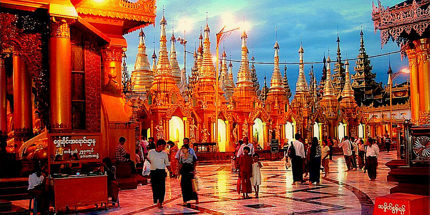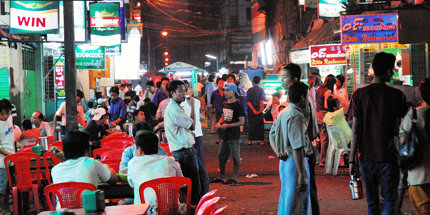24 hours in: Yangon
It may no longer be the capital of Myanmar, but Yangon is still its most engaging city, with a colonial past (even if the British-era buildings are in an advanced state of decay), and new investment increasingly evident. Here's your guide on how to spend 24 hours in the city.
EARLY RISE
First Timers
Skip your hotel’s breakfast buffet and throw yourself into the early morning bustle of one of Yangon’s many tea houses. These are social hubs as much as they are places to eat and drink, making them great for people-watching as well as for filling up.
The nation’s favourite morning dish is mohinga, noodles served in a fish broth. It may not sound like an ideal breakfast, but it’s addictive and you may soon find yourself asking your hotel whether they can rustle some up. Other popular teahouse snacks include pe byouk, boiled peas served with rice or naan bread.There are countless teahouses to choose from, but a solid and central option is Thone Pan Hla (454 Mahabandoola Road).
 Shwedagon Paya is a must-see
Shwedagon Paya is a must-seeCreative Commons / druidabruxux
Old Hands
If you’re up early and feeling energetic, a stroll along the shores of Kandawgyi Lake (north of the centre) may prove a more pleasant alternative to pushing your way through the busy streets of downtown Yangon. A boardwalk runs around and across the lake, and there are good views of 2,500-year-old Shwedagon Paya (Pagoda), one of the most sacred Buddhist sites in the country. Don’t expect unadorned nature however, as there’s a major road alongside it. Further north is the larger and less developed Inya Lake, where Aung San Suu Kyi’s home is located – tours do stop there, but there isn’t really much to see.
MORNING
First Timers
Morning is a good time to explore the streets of Yangon, before things get oppressively hot. Although the city has sprawling suburbs, you’ll find that most things of interest for a first-time visitor are within the downtown area. At its heart is Sule Paya, a 45m-tall (148ft) golden stupa which now doubles as a roundabout at the junction of Sule Paya Road and Mahabandoola Road.
From here you can wander the streets keeping an eye open for colonial-era remnants, such as City Hall and the former Immigration Department which you can see from the roundabout. Head past them along Mahabandoola Road then take a right down Pansodan Street, which has a particularly good crop of old buildings and is lined with book stalls. Try lunch at the upmarket Monsoon, on Then Byu Road, which serves a range of Southeast Asian dishes and has a handicraft shop upstairs.
Old Hands
To get a sense of rural life in the Irrawaddy Delta, you don't need to travel far at all – just take a five-minute ferry ride across the river to Dala township from the Pansodan Street jetty. The ferry runs from early in the morning for commuters, and it's easy to find a rickshaw driver on the other side to give you a short tour. It's a surprisingly sleepy area, although it will not remain that way for long once the construction of a multi-million dollar bridge linking it to Yangon is complete, estimated for late 2020.
If you don’t eat in Dala then consider lunch at Kyet Shar Soon Biryani, at the corner of Mahabandoola Street and Pansodan Street, where they do wonderful things with chicken and rice. There's a strong Indian community in Yangon, a further reminder of the colonial era.
AFTERNOON
 Bogyoke Aung San Market is a popular spot
Bogyoke Aung San Market is a popular spotCreative Commons / Der Fussi
First Timers
Escape the heat of the city streets by heading indoors. Skip the National Museum (66/74 Pyay Road), though – its treasures are poorly displayed. Far more popular is Bogyoke Aung San Market (on Bogyoke Aung San Road), which sells a little bit of everything to both locals and tourists. You can pick up some noodles for lunch here, or a great avocado shake.
Just south of here are some lively and photogenic street markets; it’s particularly worth taking a look at the fruit and vegetables on sale on 25th Street. Tucked away close by, on 26th Street, is the Musmeah Yeshua Synagogue. Built between 1893 and 1896, it now caters to a handful of Jewish families.
Old Hands
If you want to continue the theme of seeing a different side of life in and around Yangon, then take a ride on one of the commuter trains which follow a circular route starting and ending at the city’s main railway station (Kun Chan Road).
The full trip will take around three hours, although it’s worth stopping off at Hledan Market, southwest of Inya Lake, which is towards the end of the route if you’re going anticlockwise. There’s a huge array of food stalls, and as evening approaches the place fills up with students from the local university.
EVENING
First Timers
You can’t visit Yangon for the first time without going to Shwedagon Paya, the country’s most revered Buddhist site, and it’s at its best when lit up at night. Families and friends meet and worship together, and you’re likely to be approached by novices – young trainee monks – who are keen to practice their English.
 Enticing smells draw visitors to 19th street's barbecue stalls
Enticing smells draw visitors to 19th street's barbecue stallsCreative Commons / shnnn
For a simple, cheap and tasty dinner, head down to 19th Street in Chinatown. Between 5pm and 9pm, it is lined with barbecue stalls, serving up sticks of meat or vegetables typical of the Yunnan province of China. There’s also Myanmar beer available on tap from various ‘beer stations’.
Old Hands
Yangon may be only a short flight from Bangkok, but its nightlife is a world away; there are, however, still good times to be had if you know where to look. The Strand Bar (92 Strand Road) – in the city’s most impressively restored colonial-era hotel – is one of the more obvious options, but it’s worth knowing about the happy hour on Friday nights (from 5pm to 11pm). If you’re still going strong after the Strand closes, then join Yangon’s fashionable youth at the GTR Club (37 Kaba Aye Pagoda Road).
Do you have any Feedback about this page?
© 2025 Columbus Travel Media Ltd. All rights reserved. No part of this site may be reproduced without our written permission, click here for information on Columbus Content Solutions.









 You know where
You know where